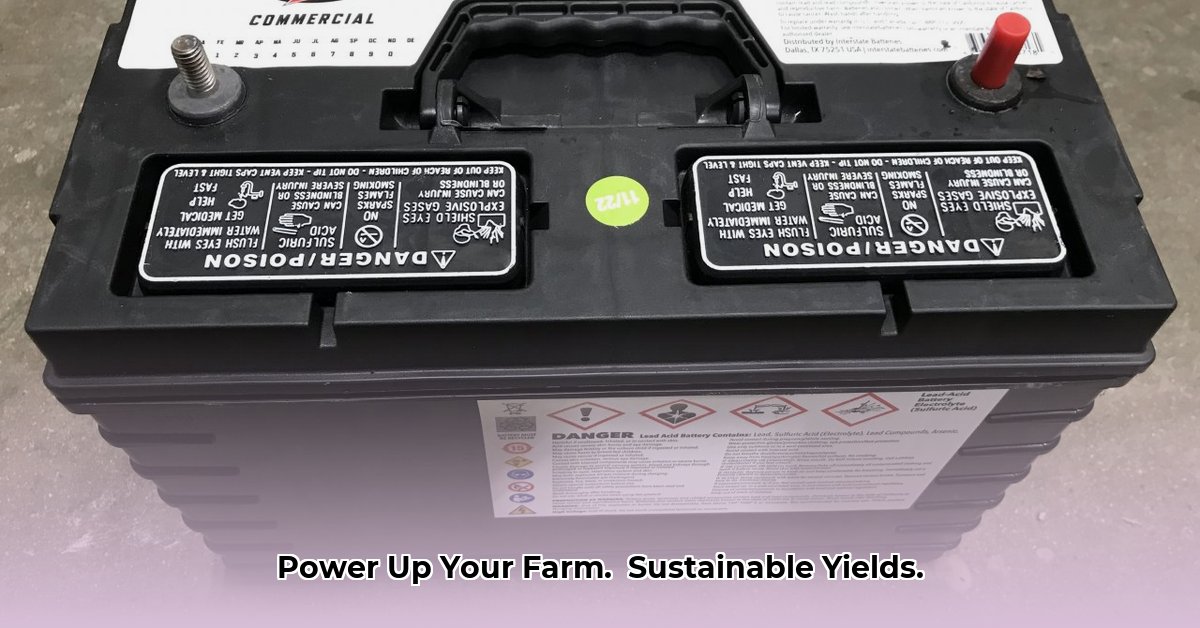
Imagine this: The sun crests the horizon, painting the dew-kissed fields in gold. Farmer Jedidiah, eager to begin his harvest, throws the switch on his tractor…nothing. A dead battery. This isn't a scene from a sitcom; it’s a harsh reality for many farmers, highlighting a critical challenge in sustainable agriculture: reliable power. This article explores how Interstate tractor batteries offer a current, dependable solution while examining the future of sustainable power in farming. We'll discuss the limitations of traditional batteries, the exciting potential of alternatives like lithium-ion, and the crucial steps needed to create a greener, more productive agricultural future. For more information on Interstate batteries, check out Interstate Batteries.
Interstate Tractor Battery: Powering Sustainable Farming
Jedidiah's story, unfortunately, isn't unique. Unreliable batteries lead to lost productivity, increased expenses, and frustrating downtime. For years, lead-acid batteries, including those from Interstate, have powered agricultural machinery. But their limitations are becoming increasingly problematic in the pursuit of sustainable farming. Their shorter lifespan requires frequent replacements, creating waste and incurring costs. Furthermore, the manufacturing and disposal of lead-acid batteries raise environmental concerns.
The Current State of Farm Power: More Than Just Juice
Modern farms rely on complex machinery, from GPS-guided tractors to automated harvesters—all demanding robust, reliable power. While Interstate batteries offer durable, readily available solutions, they represent a transition technology. The energy density of lead-acid batteries (the amount of power stored relative to size and weight) may fall short of the increasing requirements of modern, energy-intensive farming. This energy deficiency translates directly to lost productivity and financial strain for farmers. Isn't optimizing power crucial for boosting farm profitability?
The Urgent Need for Change: A Greener, More Profitable Future
Consumer demand for sustainably produced food is soaring. Farmers are under increasing pressure to minimize their environmental impact. Improving equipment efficiency, including the transition to more sustainable battery technologies, is paramount. This shift isn't just about environmental responsibility; it's about economic viability. Higher efficiency and reduced downtime directly translate into improved profitability. Are farmers prepared to embrace the long-term economic benefits of upgrading their battery systems?
Exploring Alternative Battery Technologies: Beyond Lead-Acid
Lithium-ion batteries are emerging as a strong alternative. Their superior energy density allows for longer operational times on a single charge, significantly reducing downtime. However, the higher upfront cost presents a challenge for many farmers. Furthermore, the necessary charging infrastructure in rural areas is still developing.
Comparison of Battery Technologies:
| Feature | Lead-Acid (e.g., Interstate) | Lithium-ion |
|---|---|---|
| Initial Cost | Lower | Higher |
| Lifespan | Shorter | Longer |
| Energy Density | Lower | Much Higher |
| Environmental Impact | Higher (lead production and disposal) | Lower (with responsible recycling) |
| Infrastructure Needs | Minimal | Requires access to appropriate chargers |
Actionable Steps Toward a Sustainable Power System
A successful transition requires collaboration among farmers, manufacturers, and policymakers.
For Farmers:
- Assess your energy needs: Analyze your equipment's power consumption to determine optimal battery specifications.
- Prioritize battery maintenance: Extending battery lifespan through proper maintenance minimizes replacement costs.
- Explore pilot programs: Participate in trials of new battery technologies to gain firsthand experience.
For Battery Manufacturers:
- Invest in R&D: Develop environmentally friendly, durable batteries optimized for agricultural applications.
- Enhance rural distribution networks: Ensure that sustainable alternatives are accessible to all farmers.
- Improve battery recycling infrastructure: Promote closed-loop battery recycling programs for environmentally responsible disposal.
For Governments:
- Provide financial incentives: Offer subsidies or tax credits for farmers adopting sustainable battery technologies.
- Support research and development: Fund research into next-generation battery technologies tailored to agriculture.
- Invest in charging infrastructure: Develop charging infrastructure in rural areas to facilitate the adoption of alternative batteries.
Mitigating the Risks of Transition
The transition to sustainable power isn't without its challenges. High initial costs and the need for supportive infrastructure are key obstacles. A well-structured risk assessment, along with proactive mitigation strategies, is essential for a smooth transition. For example, battery leasing programs can lessen the initial financial burden.
The Path Ahead: A Brighter, More Sustainable Future
Sustainable battery technology is essential for the future of farming. Collaboration between all stakeholders—farmers, manufacturers, and policymakers—is crucial to create a greener, more productive agricultural sector. The investment in sustainable battery technology is an investment in a more resilient and eco-friendly future for food production. The potential benefits far outweigh the challenges, promising a brighter future for both farmers and the planet.